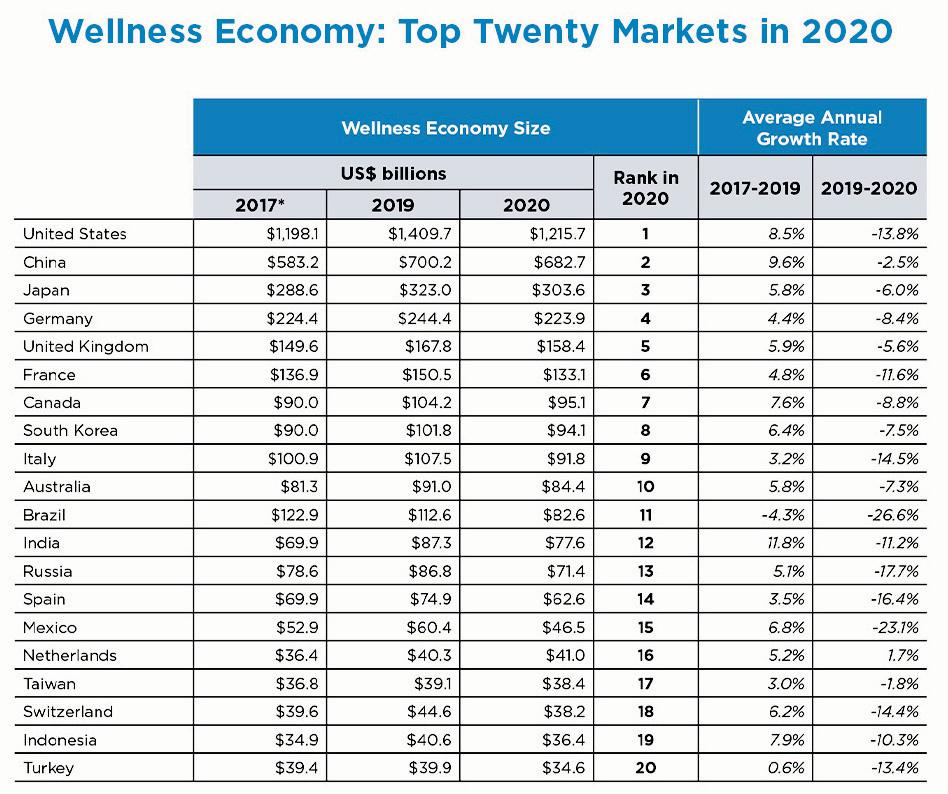
4 minute read
4 Youth-Preserving Behaviours to Embrace Now
Global Wellness Institute Research Ranks 150 Countries by Wellness Market Size By Global Wellness Institute
The nonprofit Global Wellness Institute (GWI) has released “The Global Wellness Economy: Country Rankings,” the first research to measure the wellness economies of 150 nations. It’s packed with information on national wellness markets from average wellness spend per capita to the wellness market’s contribution to each nation’s overall economy. The research was presented today at the first Global Wellness News™ broadcastin New York City.
Advertisement
The report is a companion to GWI’s recently-released “The Global Wellness Economy: Looking Beyond COVID,” a complete global update on all 11 sectors of the wellness market, finding that the world wellness economy is worth $4.4 trillion and forecast to reach $7 trillion by 2025.
“This last year, the GWI generated country-level data for all 11 wellness sectors. So now, for the first time, we can answer the question everyone asks: How big is the total wellness market for each country and who ranks highest?” said Ophelia Yeung, GWI senior research fellow.“Which nations are growing, which are shrinking? How do national wellness markets differ and why? This report is the first to answer these questions.
It’s no surprise the world’s most populous countries (e.g., China, India, Indonesia, Brazil, Russia), or the wealthiest (e.g., Switzerland, Australia, Netherlands), or countries that combine size with wealth (e.g., the US, Japan, Germany, the UK, etc.), spend the most on wellness.
The US is by far the largest market, at $1.2 trillion–nearly double the size of the second-largest market, China, at $683 billion. In fact, the US accounts for 28% of the entire global wellness market, while the top ten markets represent 71% of the world total.
The report provides granular data on national wellness markets, from growth rates in the pre-pandemic years of 2017-2019 to how the pandemic has impacted each market.

Where Do Consumers Spend the Most on Wellness? Consumers in the very wealthiest economies spend the most each year on wellness. The report provides data on how much the wellness market contributes to national GDP (what percentage of the economy it represents). Globally, the wellness economy represents 5.1% of total GDP, roughly 1 in every 20 “dollars” spent by consumers worldwide is on wellness.

For Small, Tourism-Dependent Countries, Wellness Is an Outsized Percentage of Their Economy
It may seem surprising to see Aruba rank in the top 10 for consumer spend on wellness, as it’s not as wealthy as the other ranked countries. This is the tourism effect, where high-spending inbound wellness tourists represent a disproportionate part of the wellness market. The report ranks countries by the ratio of the size of their wellness economy to the size of their total GDP/economy, and the small, tourism-dependent countries really stand out. For those top five nations, the wellness market represents an eye-opening percentage of total GDP: Seychelles (16.5%), Maldives (14.5%), Aruba (11.9%), Costa Rica (11.4%), and St. Lucia (10%). This is a window into the powerful contribution that wellness tourism brings to their economies, but also shows how in these small countries wellness is more of an “export industry” and for the most part out of reach of locals.
The Sectors That Define National Wellness Markets Vary Dramatically
The report reveals how different wellness sectors dominate in different nations. Both worldwide and in most countries, the wellness market is concentrated in three sectors: 1) healthy eating, nutrition, and weight loss; 2) personal care and beauty; and 3) physical activity. These three segments account for more than 60% of the total wellness market.
There is however a wide national and regional variance. In Japan, personal care/beauty represents a much bigger share of wellness spending than in most countries; for China, India, Indonesia, Russia, and Turkey, it’s traditional/complementary medicine; in Germany, it’s wellness tourism, spas and thermal/mineral springs; while in Sub-Saharan Africa, public health and prevention spending dominates.
“These new rankings reveal the countries that spend the most on wellness–important information for governments and businesses. But the size of a wellness market does not necessarily capture which countries are most ‘well’: which nations have the best health outcomes or fair access to wellness,” said Katherine Johnston, GWI senior research fellow. “There’s much research to do. Who is benefitting from the growth of the wellness economy in each country, and who is not? What’s the relationship between the wellness market and the health and well-being of a nation’s population? What can governments and policymakers do to bring more wellness to more people? This will be the focus of our November 2022 report on wellness and policy to be released at the Global Wellness Summit in Tel Aviv.”











